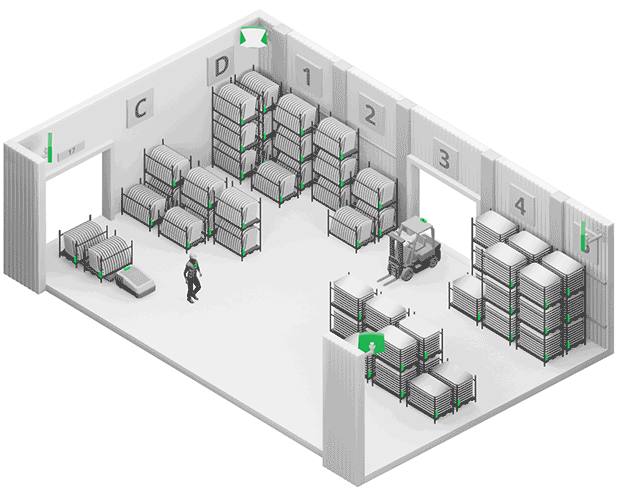Real Time Location Tracking Systems (RTLS)
Another key component to achieving a smart factory
In today’s environment, market dimensions change at a tremendous rate. Global events and pandemics have an impact on every aspect of business, regardless of size. To remain competitive, prosper in the global market, and win in the long run, manufacturers must employ world-class strategies, technologies and systems. Industry 4.0 technology is having a significant impact on manufacturing, product and production line design, operations and service. RTLS technology may be one of the keys to enabling a smarter factory strategy, because of its numerous benefits and delivered value.
Real Time Location Tracking Solution Use Cases

The following are some RTLS application cases that may be highly advantageous to manufacturers:
- Shopfloor Vehicle Tracking– forklift trucks, tuggers and trailers
- Material Flow Tracking– pallets, totes, movable vessels, high-value products
- Asset Tracking– improve inventory management inside or outside (in the factory yard) with accurate positioning placement
- Improving Made-To-Order Prioritization and Warehouse Productivity
- Employee Logistics EfficiencyTracking – allows collection of positioning data while gathering valuable insights on people “process logistics” efficiency, dwell time and status.
- Employee Safety– system’s ability to track personnel can help improve safety by issuing warnings when approaching hazardous areas and also enable faster responses to safety incidents.
- Using Asset Positioning Data to Update Digital Twins
The Value in Connecting RTLS To SAP DM
The SAP Digital Manufacturing Suite and SAP Enterprise Business networks allows for real-time information sharing and access to real time data required for advanced analytics. Positioning data may prove very valuable to extending analytics and even providing Lean insights to reduce movement waste.
The below architecture depicts the intimate integration with SAP’s manufacturing platforms.

The Technology That Makes It All Work
For real-time position tracking, numerous technologies are available. Each has its own set of merits and limitations in terms of accuracy, cost, scalability and signal coverage. As a result, for effective RTLS implementation, RTS chooses the appropriate technology depending on the application performance requirements. Some of the important technologies used to implement RTLS solutions are:
- Ultra-Wide Band– UWB is a cutting-edge RF technology that delivers centimeter-level location precision. It can transfer data at incredible rates over small distances while determining accurate position in real-time and with extremely low latency.
- Bluetooth Low Energy (BLE)– This technology operates on the standard Bluetooth frequency and uses less power. Receivers are frequently linked to the cloud, which facilitates the implementation of cloud-based applications.
- Wi-Fi positioning service (WPS)– The data can be transmitted using Wi-Fi signals. Here, the position of the tracked object is determined using the Time of Arrival and signal strength.
- Infrared– When you require low-cost, room-level location intelligence, an IR RTLS is a great option. It may be a cost-effective option if your objective is to pinpoint the room where an asset is situated.
- Chirp Spread Spectrum (CSS)– It is a novel RF technology with standout benefits including low power consumption, indoor and outdoor compatibility, and long-range positioning.
Accurate Location Tracking
RTLS positioning systems aid in the optimization of manufacturing object movements such as materials, components, pallets, etc, and their conveying vehicles such as forklift trucks, mobile robots or automated guided vehicles, tools, as well as work-in-progress and finished goods.
Manufacturers can benefit from tracking the exact location of conveying vehicles used for material and production orders throughout the plant. Hence, accurate positioning of shopfloor assets can transform your manufacturing space or warehouse into smarter facilities to improve productivity and safety.
Solutions
Manufacturers must be able to control workflow. Material/product tracking while making sure there are no shortage of parts for production can bring “just in time” to a new level of performance with RTLS. By relieving supervisors from their material searching tasks, they are provided more time to focus achieving production schedules and strategic initiatives.
When companies engage their employees to help them grasp the benefits of RTLS asset tracking, even more ideas emerge to ultimately improve customer satisfaction and company profits.

A Summary of Real-Time Asset Tracking, Insights
- Shop-floor data acquired by RTLS enables identifying production bottlenecks, improving traceability, all while making manufacturing operations more effective and scalable.
- Automatically confirm “line-side” or “custody transfer” of material delivery
- The ability to quickly establish an infinite number of virtual zones that may be modified to meet future logistical process requirements.
- Enables virtual zone adaptability and variation without requiring any infrastructure changes.
- Provides continuous geo-tracking of objects unlike RFID that provide only detection of presence.
- Operates 24/7
- Short time for deployment (3 to 4 months).
- Tracking sensor long battery life
- Low maintenance and higher reliability.
- The ability to scale the system easily and quickly to track more objects and expand the system to more zones.
- Precise and can operate in tough metallic and variable conditions.
Manufacturers can benefit from tracking the exact location of conveying vehicles used for material and production orders throughout the plant. Hence, accurate positioning of shopfloor assets can transform your manufacturing space or warehouse into smarter facilities to improve productivity and safety.
